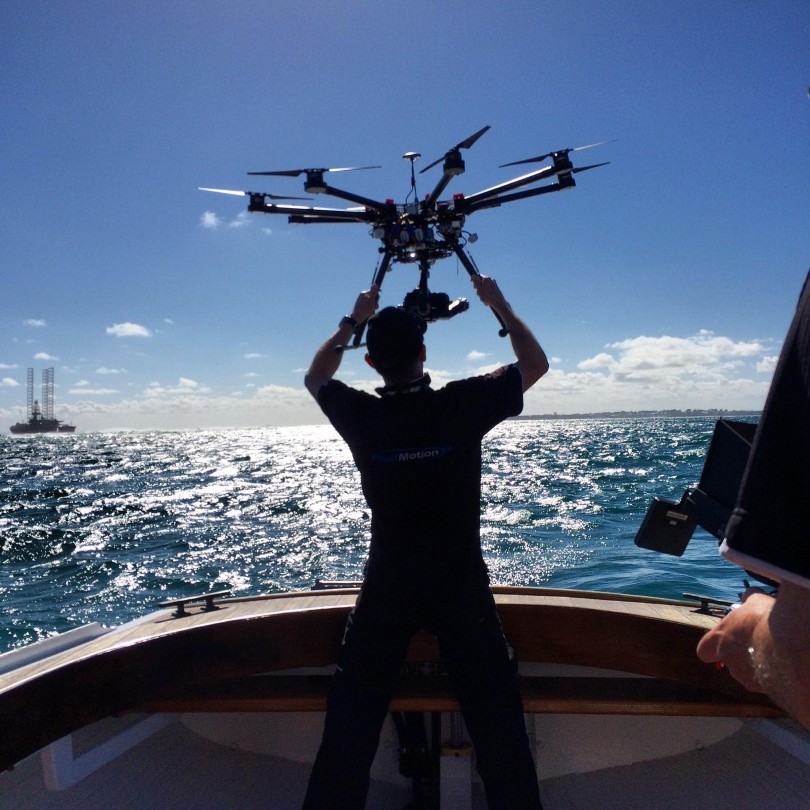Fluid Motion‘s Dale Henderson is looking down on his film set from forty feet in the air. His eyes are angled wide, focusing, then refocusing. On the controls, his hands are steady – and they’d want to be. He’s flying the future of the film industry.
Four years ago, when Australia started using drones (or Unmanned Aerial Vehicles -‘UAV’) in cinematography, Dale was the first broadcast cameraman on board – the “crash test dummy” as he tells it.
Since then, drones have buzzed around parties in The Wolf of Wall Street, helped wow judges at the Melbourne International Film Festival and almost gotten tangled in Johnny Depp’s beard during last month’s filming of the fifth Pirates of the Caribbean film.
So why are more and more cinematographers now arming themselves with pilot’s licenses as well as tripods?
1. Agility
“Drones are game changers for film,” Dale told The City Journal. “It’s a tripod in the air basically. All of a sudden you can drop a drone into a hole or push it through trees and buildings so it’s opened up this new dimension of creativity.”
Fresh from the set of Pirates of the Caribbean: Dead Men Tell No Tales, Director at XM2 Aerial Stephen Oh agreed.
“A drone’s like a cross between a dolly, a technocrane and a helicopter,” he said.
And now perhaps a hydra. XM2 recently revealed their “dual drone” prototype – a world-first with two cameras mounted on its underbelly.
2. Efficiency
As Production Manager at XM2, Quentin Peel likes things to run smoothly – and having a drone on set can cut down delays dramatically.
“Moving say a technocrane between locations can take hours,” Quentin said.
“If you get a drone to do the same thing, your entire set-up is maybe 30 minutes so all of a sudden the production day moves much faster.”
And the environment could benefit as well.
“Let’s remember helicopters are also using fuel, lots of fuel,” Quentin said.

From left: XM2’s Stephen Oh and Quentin Peel with production co-ordinator Jin Won Lee and pilot Luke Annells.
3. Cost
According to Dale Henderson, helicopters can cost up to $8,000 an hour, meaning production companies often find “more value for money” with drones.
“Of course, you might think you’re doing right by your budget by booking just the cheapest operator,” he adds. “But you can end up wearing a drone in the back of your head that way too.”
“There’s a lot of cowboys out there,” Quentin said.
“People doing it the wrong way can ruin it for those of us following regulations.”
4. Noise
While XM2’s monster 40-kilo drone may be one of the largest, it’s nothing compared to a “ten tonne” helicopter.
“Helicopters are great for long-range shots but up close they’re noisy, they’re blowing out sand dunes,” Dale said.
5. Stalking potential
Of course, eyes in the sky might be trained on actors even when they’re not on set. Talk of paparazzi drone fleets is now racking the entertainment industry.
Last year, Kanye West used a court deposition to confess his fears that drones flying over his house could crash into his pool and electrocute his daughter.
Even on set with XM2’s drone (now called Johnny’s Drone 2), Mr. Depp couldn’t avoid other curious aircraft sneaking in for a shot.
Dale said tougher drone privacy laws could be a good thing for the industry.
“They’re hovering over someone’s house, they’re not working,” he said. “We’ll still be here working.”
Close encounters of the paparazzi kind #pirates5 #australia A video posted by Joachim Rønning (@joachimronning) on
Image: supplied




[…] published on The City Journal (September 1 […]